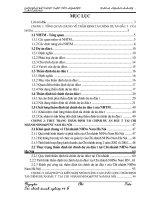Kế toán công cụ. Các phương pháp thẩm định đầu tư đánh giá và xếp hạng các cơ hội tiềm năng
Bạn đang xem bản rút gọn của tài liệu. Xem và tải ngay bản đầy đủ của tài liệu tại đây (137.26 KB, 11 trang )
TABLE CONTENT
I)Introduction......................................................................................... 2
II)Main ideas:......................................................................................... 2
1)Reason for take over:...............................................................................2
2)Methods to takeover a company:............................................................3
3)There will be some impacts that affect to the company:......................4
4)Methods of investment appraisal to evaluate and rank potential
opportunities ...............................................................................................4
5)The nature of gearing and the potential effects of high gearing on
perceived risk and cost of capital...............................................................5
III)Inconclusion:..................................................................................... 7
Appendix................................................................................................. 8
Reference:............................................................................................. 11
1
I)Introduction
Jebb Plc directors have identified a number of projects which they
believe will be successful in increasing the wealth of the shareholders. One of
the proposed projects is the takeover of a rival company that competes with
Jebb plc for market share in their core business. The report will analyze the
reasons behind takeovers and the methods by which such takeovers may take
places together with the potential effects of a takeover. Four method of
investment appraisal will be given with their pros and cos. Moreover, the
nature of gearing and potential effected of high gearing on perceived risk and
cost of capital.
II)Main ideas:
1)Reason for take over:
A takeover is the purchase of one company by another. There are many
reasons behind takeover such as:
a) Market share: the companies want to look toward a higher market share. When
takeover a competitive company, Jebb will have bigger economic of scales, thus, the price
per unit will reduce. The company takes advantage of price competitive. The acquisition of a
large competitor is a reasonable way to attain significant market share.
b) Tax: Take over brings more profits for the shareholder because the tax liability of
the combination will be lower than two individual company.
c) Geographic reach: Strong company always wants to expand their market in a new
geographic. But it is big challenge of understanding and operating in new local culture. Thus,
it is easier and faster for Jebb to acquire local company than building one.
d) Market share: When, Jebb acquires a rival company, the resultant organization can
increase the market share because the new company will take advantage of cost efficiency
and competitive as compared to its financially weak parent organization
1
.
1
/>2
e) Synergy: Reduce production cost and administrative costs is one part of synergy.
Furthermore, it is also arise from enhanced managerial capabilities, human resources, R&D
investment, etc. Other business will also bring new skills and specialist departments to the
Jebb.
2
f)Reduce risk: Inherent risk will be reduced resulting from diversification of product s
and services. If one product fails due to market conditions, the other products in another
market won’t be affected. The combination of management, strengthen the capacity of
combined firm, diversification of product and services, will help the new firm to withstand
bad unforeseen economic factor.
g) Reduce competition because a rival is taken over.
2)Methods to takeover a company:
There are 3 methods to takeover a company
a) Cash offer:
Cash offer is an offer to buy a publicity- traded company in exchange for cash. A
cash offer may be either friendly or hostile. Before making offer to a company, bidder
company usually inform to board of directors first. In private company, board directors and
shareholders have closely connected, thus if the boards accept the offer, the shareholder also
agreed. Private acquisition is friendly. However, if the boards and shareholders reject the
offer, but the bidder still continues to peruse it without inform to them. It is called hostile
takeover.
3
There are some advantage for bidding company is they can see exactly how much
is offered and it has no effect to issued shares. However, by cash offer method, the seller
may be liable to pay capital gains tax on shares sold to bidder.
b) Share for Share offer:
The acquiring firm offers its share for an equal number of shares in the target firm. If
accept both shareholders of two companies become owners of resulting company.
4
By this
method, the target company shareholders could retain equity interest in their company. There
is no brokerage costs from re-investing cash and no capital gains tax liability. However,
acquiring company might take some disadvantages such as the company should keep the
offer price not fall in market price.
c) Mixed bid:
Mixed bid method is used when a share for share offer is supported by a cash
alternative. It is popular financing choice because it is more accepted by target company’s
shareholder.( Corporate finance book)
2
/>3
/>4
/>3
3)There will be some impacts that affect to the company:
a) Economies of scale: Combination of two business will support economies of
scale e.g.: increase in productivity and output, increase cost efficiency, long term cost might
reduce. The larger economic of scale, the bigger of amount of products will be produced
whereas unit cost will decrease.
b) People: From a survey in 1985 of Training Magazine, 85 % top executive
believed that people problem were more likely affect a acquisition’s long term success. Two
different company, they have different value, performance, behavior and attitude. Thus it
might be lead to big conflicts in new company after acquiring. Thus, managerial
communication contributes an important role in organizational acquisition. Managers should
aware of acquisition’s potential affect to employees’ attitude and performance, what are their
expectation.
c) Financial:
According Ansof ( 1971), it stated that after an acquisition, low sales growth
companies showed significant higer rates of growth, whereas, high sales growth companies
showed lower rates of growth. Low sales growth companies showed higher rates of growth
after acquisition, they still suffered decreasing in P/E ratios.
4)Methods of investment appraisal to evaluate and rank potential
opportunities
There are four methods the company can use to evaluate opportunities:
a) Payback period:
“Payback period is the time required to cover the initial investment in a project
“( C.Paramasivan, 2003, p122)
Payback period =
Pros: It is an easy way to compute and simple for managers, shareholders to
understand. It also reduces the possibility of loss on account of obsolescence and handles
investment risk effectively
Cons: The method doesn’t recognize the Time value of Money and it ignores
profitability of an investment.
b) Accounting Rate of Return:
“ARR means the average rate of return or profit taken for considering the project
evaluation.” ( C.Paramasivan, 2003, p127)
ARR % x 100
4
Pros: This method is based on the accounting information rather than cash flow.
Moreover, it considers the total benefits associated with the project. It is easy to calculate
and simple to understand
Cons: It ignores the time value of money and the reinvestment potential of a
project. It doesn’t adjust for the greater risk to longer term forecasts.
5
c) Net present value
According Financial management book, NPV is one of modern methods for
evaluating the project proposals. It describes as the summation of the present value of cash
inflow and present value of cash outflow. It is the difference between total present value of
future cash inflows and the total present value of future cash outlows.
Pros: It recognize the time value of money. The value of dollar today is more than
the value of a dollar received a year from now. NPV also recognize the risk associated with
future cash flow. It helps to maximize shareholders’ profit.
Cons: It doesn’t tell us when a positive NPV is achieved, it only tell us to accept all
investment with NPV > 0. Furthermore, the method assumes that capital is abundant. There
is no capital rationing.
d) Interest Rate of Return:
Interest rate of return is time adjusted technique and it is a rate at which discount
cash flows to zero. It is calculated by the ratio: Cash inflow/ Investment initial.
Pros: It accounts the time value of money, gives the nearest rate of return. It also
provide guidance on a project’s value and associated risk
6
.
Cons: It is complicated to calculate. It produces multiple IRR if evaluating a
project that has more than one change in sign for the cash flow stream. In addition, IRR
assumes that all intermediate cash flows are reinvested at the internal rate.
5)The nature of gearing and the potential effects of high gearing on
perceived risk and cost of capital
a) Source of finance:
Depend on the amount of capital needed, the firm will choose the suitable source of
financial. There are 4 kinds of sources of finance:
• Based on the period:
- Long term Sources: Equity shares, Preference shares, debenture, long term loans,
fixed deposites.
- Short term sources: Bank credit, customer advances, trade credit, factoring,
public deposits.
• Based on ownership capital:
Ownership capital is the capital owned by the shareholders. The company can rise
substantial funds through an IPO. There are two types of share can be issued : Ordinary share
and preference share. Furthermore, retained earning is also an ownership source.
• Based on sources of generation:
5
/>6
/>5








